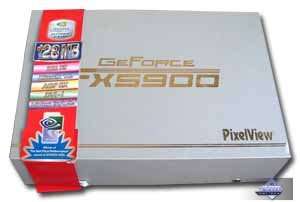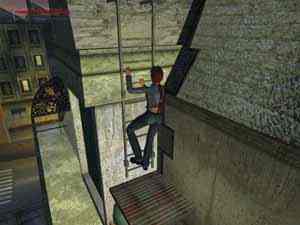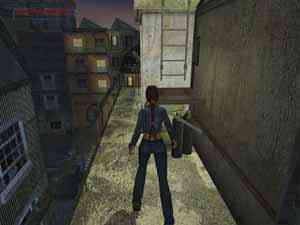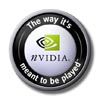 |
||
|
||
| ||
CONTENTS
Today we will test one more video card based on the NVIDIA GeForce FX 5900. It seems that there's nothing to add to this subject. But it's wrong. First of all, High-End products and any alterations in this price niche indicate that the developers work hard trying to improve performance and drivers. Secondly, performance of expensive video cards is always in the center of attention, especially of those who can't afford them, and every mistake of driver developers is strictly judged. Today we'll deal with a new (in our lab, not on the market) card based on the GeForce FX 5900 and test performance of such cards in the new sensational benchmark based on the game Tomb Raider: Angel of Darkness. Although NVIDIA's fans should enjoy the whole process, it's really only Prolink's card that gives real pleasure.
Theoretical materials and reviews of video cards which concern functional
properties of the GPU NVIDIA GeForce FX
As usual, Prolink, Taiwanese manufacturer, offers a full line of video cards based on NVIDIA's processor. By the way, there are also also TV tuners and other multimedia devices produced under the PixelView trade mark. The advantage of this FX 5900 based card is the lowest price on our market, though the card combines the reference design, high-grade quality and gold-plated surface...
Card
|
|||||||||||||||||||||||||||||||||||||||||||||||||||||||||||||||||||||||||||||||||||||||||||||||||||||||||||||
| Prolink PixelView GeForce FX 5900 128MB |  |
| Prolink PixelView GeForce FX 5900 128MB | |
| AGP
x8/x4/x2 interface, 128 MB DDR SDRAM memory in 8 chips on top.
Hynix 2.2ns memory chips, it corresponds to 454 (908) MHz but the memory works at 426 (850) MHz. GPU clocked at 400 MHz. 256bit memory bus. |
 |
| Comparison with the reference design, front view | |
| Prolink PixelView GeForce FX 5900 128MB | Reference card NVIDIA GeForce FX 5900 |
 |
 |
 |
|
| Comparison with the reference design, back view | |
| Prolink PixelView GeForce FX 5900 128MB | Reference card NVIDIA GeForce FX 5900 |
 |
 |
| Prolink PixelView GeForce FX 5900 128MB | |
|
The card ships together with a user manual, software CD (WinDVD included), VIVO adapter/splitter, TV extension cords, S-Video-to-RCA adapter, external power supply splitter. |
 |
| Prolink PixelView GeForce FX 5900 128MB | |
|
The package matches the card. The tender silvery box with buttons and a tape has the card name and basic features written on it. |
 |
|
| Prolink PixelView GeForce FX 5900 128MB | 1600x1200x85Hz, 1280x1024x120Hz, 1024x768x160Hz |
Cards' performanceTest application:
If you want to get the demo benchmarks that we use let me know by e-mail. First the cards were tested with the maximum settings, just Depth of Fields PS20 and PS20 Shadows were turned off (the first one worked with errors on the GeForce FX with patch 49, and in the second case the game failed to start on the GeForce FX again on patch 49). These bugs are fixed on the patch 52, but it's not any case to benchmark with patch 52. All settings were the same for all the cards tested. |


|
The settings circled were originally changed relative to the default ones. But we got NVIDIA's official respond where they insisted on testing with the default settings: |


|
It should be noted that the the game and patch 49 were reinstalled for testing cards from a different camp to avoid problems with game settings for the RADEON 9800 PRO and GeForce FX 5900. Also note that when the game detected the RADEON 9800 PRO and the GeForce FX 5900 the default settings were also equal and they are shown above. As you can see, some functions are disabled, and the Cubemaps reflections section sets 16bit color and Z buffer depths. Paris5_4 DEMO   This scene intensively uses shader technologies. What can I say about the GeForce FX 5900? Unfortunately, nothing. Well, when the DX9 game was released the low pixel shader speed couldn't assure any decent performance. It's due time to cut prices for the FX5900! I hope NVIDIA's price policy will rescue such cards as the number of games that actively use PS 2.0 will be increasing. Note that disabling Glow, FOG and trilinear filtering has almost the same effect on both cards. Quality (all quality parameters were measured at the maximum settings):
|
| RADEON 9800/FX 5900 without DoF PS2.0 | FX 5900 with DoF PS2.0 (Patch 49!) |
| Example 1 | |
 |
 |
| Example 2 | |
 |
 |
| Example 3 | |
 |
 |
|
Paris1c DEMO   Obviously, this picture is still sad for the GeForce FX though the difference
is not that big. No shaders can raise the speed if the chip itself is not able
of it Quality: |
| RADEON 9800/FX 5900 without DoF | FX 5900 with DoF (Patch 49!) |
| Example 1 | |
 |
 |
| Example 2 | |
 |
 |
| Example 3 | |
 |
 |
|
Paris2g DEMO   The scene that doesn't use so many shader technologies doesn't let the FX
5900 lose so awfully (and with the default settings the GFFX and R9800 PRO have
equal scores). Well, the more shaders, the weaker the GeForce FX. Strangely enough, but the RADEON 9800 PRO works faster at the maximum settings in this game than at the default ones. We checked it several times, that is why there must be a flaw in the game itself. Quality: |
| RADEON 9800/FX 5900 without DoF PS2.0 | FX 5900 with DoF PS2.0 (Patch 49!) |
| Example 1 | |
 |
 |
| Example 2 | |
 |
 |
There are no test results in the AA and anisotropy modes as the FPS is low even without them. Just remember that they do not change the general picture of the cards' performance.
Note.
Just before this review was published we found the patch 52 for this game on the Net. It doesn't support benchmarking anymore. But it's still possible to compare the GeForce FX 5900 and RADEON 9800 PRO with the FRAPS. The speeds remain the same, that is why the patch 52 doesn't improve performance of the NV35.
Remember! Patch 52 fixed many bugs (DoF PS2.0, PS2.0 Shadows), but it has not benchmark.
Also note that we checked all measurements taken with the integrated benchmark with the FRAPS utility. The figures differed by just a little margin, that is why we can consider the scores to be true. It was done to prevent claims that the integrated benchmark works incorrectly.
The card itself looks pretty good among its competitors: it has a low price and such advantages as perfect build quality, attractive appearance and package.
On the other hand (it concerns all GeForce FX based cards), such cards fall far behind their RADEON based competitors in the games that use a lot of DirectX 9.0 shader technologies. As to the TR:AoD game, it's for a user to choose settings. I didn't notice much difference between maximum and default settings. Meticulous users will notice it. That is why we tested both modes. I didn't compare screenshots with the maximum and default settings since I want to wait for the official release of NVIDIA's drivers v5x.xx, and secondly, benchmarking in TR:AoD will be soon carried out once again, and we will closer exmine the difference in quality.
As to the GeForce FX 5900, there is no wayouts other than to cut prices for the FX5900 relative to the RADEON 9800 PRO to increase their demand in spite of a low shader speed.
In our 3Digest you can find full comparison characteristics for video cards of this and other classes.
 In closing let me tell you a little on the program called "The Way It's
meant To Be Played". You have probably noticed such logo on some game CDs
and packages of graphics cards from various card makers. It means that NVIDIA
jointly works with the game developers to provide best compatibility of their
products with NVIDIA based cards. NVIDIA's official position is as follows: This
is just a program of ensuring compatibility with NVIDIA's products, and it's not
aimed at all at accelerating NVIDIA's GPUs and slowing down competitors' ones.
In closing let me tell you a little on the program called "The Way It's
meant To Be Played". You have probably noticed such logo on some game CDs
and packages of graphics cards from various card makers. It means that NVIDIA
jointly works with the game developers to provide best compatibility of their
products with NVIDIA based cards. NVIDIA's official position is as follows: This
is just a program of ensuring compatibility with NVIDIA's products, and it's not
aimed at all at accelerating NVIDIA's GPUs and slowing down competitors' ones.
Recently we got the first Russian game within the frames of this program - Operation: Silent Storm from NIVAL (Publisher 1Ñ).
Above you can see NVIDIA's official position regarding the program "The Way It's meant To Be Played". You can get more information about it on Tom's Hardware site.
Write a comment below. No registration needed!
|
Article navigation: |
| blog comments powered by Disqus |
| Most Popular Reviews | More RSS |
 |
Comparing old, cheap solutions from AMD with new, budget offerings from Intel.
February 1, 2013 · Processor Roundups |
 |
Inno3D GeForce GTX 670 iChill, Inno3D GeForce GTX 660 Ti Graphics Cards A couple of mid-range adapters with original cooling systems.
January 30, 2013 · Video cards: NVIDIA GPUs |
 |
Creative Sound Blaster X-Fi Surround 5.1 An external X-Fi solution in tests.
September 9, 2008 · Sound Cards |
 |
The first worthwhile Piledriver CPU.
September 11, 2012 · Processors: AMD |
 |
Consumed Power, Energy Consumption: Ivy Bridge vs. Sandy Bridge Trying out the new method.
September 18, 2012 · Processors: Intel |
| Latest Reviews | More RSS |
 |
Retested all graphics cards with the new drivers.
Oct 18, 2013 · 3Digests
|
 |
Added new benchmarks: BioShock Infinite and Metro: Last Light.
Sep 06, 2013 · 3Digests
|
 |
Added the test results of NVIDIA GeForce GTX 760 and AMD Radeon HD 7730.
Aug 05, 2013 · 3Digests
|
 |
Gainward GeForce GTX 650 Ti BOOST 2GB Golden Sample Graphics Card An excellent hybrid of GeForce GTX 650 Ti and GeForce GTX 660.
Jun 24, 2013 · Video cards: NVIDIA GPUs
|
 |
Added the test results of NVIDIA GeForce GTX 770/780.
Jun 03, 2013 · 3Digests
|
| Latest News | More RSS |
Platform · Video · Multimedia · Mobile · Other || About us & Privacy policy · Twitter · Facebook
Copyright © Byrds Research & Publishing, Ltd., 1997–2011. All rights reserved.